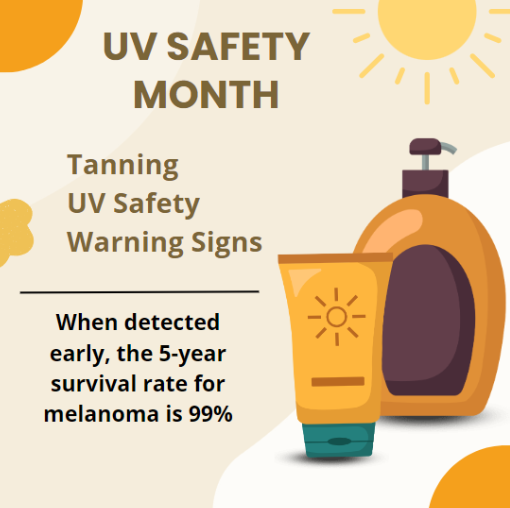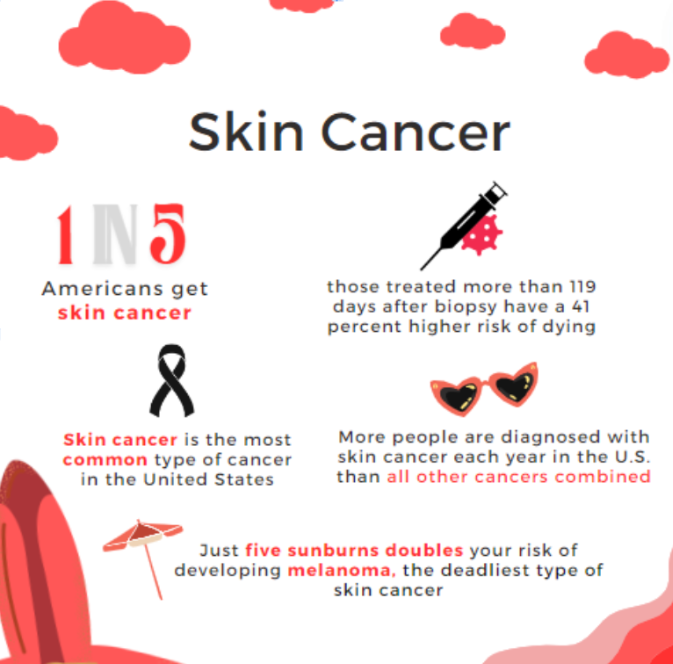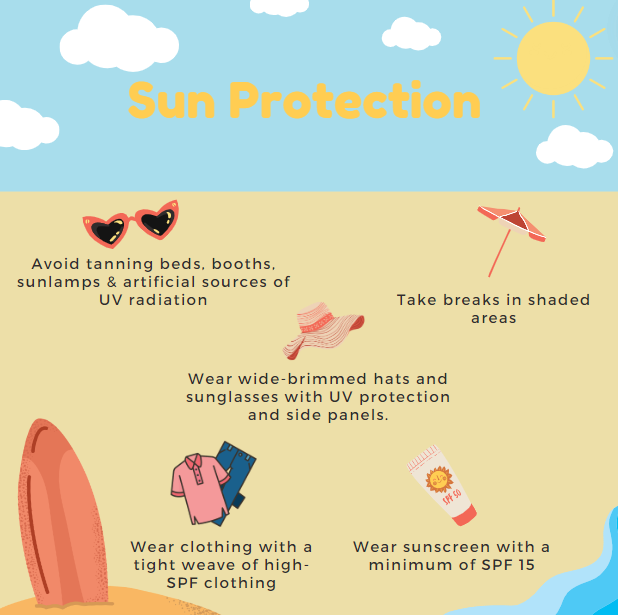Written By: Ayaan Olasewere, SMCHD Intern

Ultraviolet (UV) Safety Month, observed in July, works to raise awareness about the dangers of UV radiation and its role in causing skin cancer. During the summertime, many people spend extended periods of time under the sun, often unaware of the potential consequences. Whether attending camps, flocking to beaches, or enjoying pools, sun exposure is a common activity. While sunlight is necessary for your body to process vitamin D, ultraviolet radiation can harm and damage the skin, regardless of skin tone. Misinformation about the dangers of UV radiation is widespread, but the St. Mary’s County Health Department offers various programs designed to educate our community, combat stigma, and promote sun safety practices.
Every year, as the weather warms up and the UV index rises, Americans of all ages flock outdoors with the goal of getting as tan as possible. This emphasis on tanning and unhealthy tanning behaviors significantly increases the risk of skin cancer. Despite knowing that UV light exposure is a major cause of skin cancer, many people continue to use risky methods, such as permanently getting a sunburn in order for them to tan.
A tan is a sign that your skin is trying to protect itself from UV radiation, which means it is a sign of skin damage. There is no such thing as a ‘safe’, or ‘controlled’ tan.
Indoor tanning, whether from tanning beds, tanning booths, or sun lamps, is equally dangerous and can increase the risk of developing skin cancer by up to 58%, with the risk increasing with each use. This exposure to UV radiation, whether from the sun or artificial sources, not only increases your risk of skin cancer but also accelerates skin aging, causing 80% of visible facial aging. The more your skin is exposed to UV radiation, the higher your risk of skin cancer and the faster your skin will age.
The SMCCD cancer screenings also help residents receive education on proper behaviors. The Maryland Health Department and the Centers for Disease Control and Prevention (CDC) offer further information about the dangers of tanning.
Due to the misinformation about skin cancer, many false beliefs circulate in society, one of the most harmful being that skin cancer only affects certain skin tones. In reality, it is scientifically proven that skin cancer affects people of all colors. People with darker skin tones often believe they are immune from the skin’s consequences because they rarely tan or burn, but this is not true. While people with darker skin tones may be more resistant to sun damage, you’re susceptible to skin cancer. Furthermore, skin cancer in people of color is often diagnosed at a later stage when it’s harder to treat. Therefore, individuals of African, Asian, Latino, Mediterranean, Middle Eastern, and Native American descent must be vigilant in managing their sun exposure and checking themselves for skin cancer.
One of the best ways to protect yourself is to understand the warning signs of skin cancer: what to look for and where to look. On darker skin, skin cancer often appears in areas with less sun exposure, such as the palms of hands, soles of feet, and under and around the nails. It is important to check yourself monthly and visit a dermatologist annually for a full-body exam. If you notice anything new, no matter how benign it seems, contact a dermatologist immediately.
The SMCHD cancer screenings provide residents with access to recommended cancer screening services for free. Some warning signs that may prompt a visit to a dermatologist are

Everyone is exposed to the sun’s ultraviolet rays, even on cloudy days, so it is important to adopt behaviors to protect yourself from sun exposure. While it may be unreasonable to avoid the sun entirely, there are several ways to reduce UV exposure, including

The post UV Safety: Protecting Yourself from Harmful Radiation appeared first on St. Mary's County Health Department.

UV Safety
Ultraviolet (UV) Safety Month, observed in July, works to raise awareness about the dangers of UV radiation and its role in causing skin cancer. During the summertime, many people spend extended periods of time under the sun, often unaware of the potential consequences. Whether attending camps, flocking to beaches, or enjoying pools, sun exposure is a common activity. While sunlight is necessary for your body to process vitamin D, ultraviolet radiation can harm and damage the skin, regardless of skin tone. Misinformation about the dangers of UV radiation is widespread, but the St. Mary’s County Health Department offers various programs designed to educate our community, combat stigma, and promote sun safety practices.
Dangers of Tanning
Every year, as the weather warms up and the UV index rises, Americans of all ages flock outdoors with the goal of getting as tan as possible. This emphasis on tanning and unhealthy tanning behaviors significantly increases the risk of skin cancer. Despite knowing that UV light exposure is a major cause of skin cancer, many people continue to use risky methods, such as permanently getting a sunburn in order for them to tan.
A tan is a sign that your skin is trying to protect itself from UV radiation, which means it is a sign of skin damage. There is no such thing as a ‘safe’, or ‘controlled’ tan.
Indoor tanning, whether from tanning beds, tanning booths, or sun lamps, is equally dangerous and can increase the risk of developing skin cancer by up to 58%, with the risk increasing with each use. This exposure to UV radiation, whether from the sun or artificial sources, not only increases your risk of skin cancer but also accelerates skin aging, causing 80% of visible facial aging. The more your skin is exposed to UV radiation, the higher your risk of skin cancer and the faster your skin will age.
The SMCCD cancer screenings also help residents receive education on proper behaviors. The Maryland Health Department and the Centers for Disease Control and Prevention (CDC) offer further information about the dangers of tanning.
Skin Cancer Affects ALL Skin Tones
Due to the misinformation about skin cancer, many false beliefs circulate in society, one of the most harmful being that skin cancer only affects certain skin tones. In reality, it is scientifically proven that skin cancer affects people of all colors. People with darker skin tones often believe they are immune from the skin’s consequences because they rarely tan or burn, but this is not true. While people with darker skin tones may be more resistant to sun damage, you’re susceptible to skin cancer. Furthermore, skin cancer in people of color is often diagnosed at a later stage when it’s harder to treat. Therefore, individuals of African, Asian, Latino, Mediterranean, Middle Eastern, and Native American descent must be vigilant in managing their sun exposure and checking themselves for skin cancer.
One of the best ways to protect yourself is to understand the warning signs of skin cancer: what to look for and where to look. On darker skin, skin cancer often appears in areas with less sun exposure, such as the palms of hands, soles of feet, and under and around the nails. It is important to check yourself monthly and visit a dermatologist annually for a full-body exam. If you notice anything new, no matter how benign it seems, contact a dermatologist immediately.
The SMCHD cancer screenings provide residents with access to recommended cancer screening services for free. Some warning signs that may prompt a visit to a dermatologist are
- Changes in existing skin spots
- A lump
- A sore that does not heal
- Abnormal moles
- A spot that weeps or bleeds

Protection from the Sun
Everyone is exposed to the sun’s ultraviolet rays, even on cloudy days, so it is important to adopt behaviors to protect yourself from sun exposure. While it may be unreasonable to avoid the sun entirely, there are several ways to reduce UV exposure, including
- Wearing sunscreen with a minimum of SPF 15
- The SPF is how long a person will be protected from a burn, SPF 15 means that a person can stay in the sun 15 times longer before burning.
- To protect against UVA, look for products containing: Mexoryl, Parsol 1789, titanium dioxide, zinc oxide, or avobenzone
- Some sunscreens may lose their effectiveness when applied with insect repellents. You may need to reapply more often.
- Wear clothing with a tight weave of high-SPF clothing
- Wear wide-brimmed hats and sunglasses with UV protection and side panels.
- Take breaks in shaded areas
- It is also important to avoid tanning beds, booths, sunlamps, and other artificial sources of UV radiation and to use protective clothing, UV shields, and filters when exposed to UV in the workplace

The post UV Safety: Protecting Yourself from Harmful Radiation appeared first on St. Mary's County Health Department.
